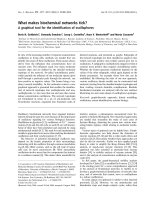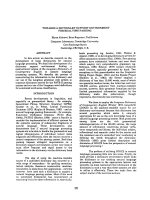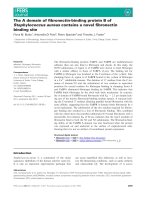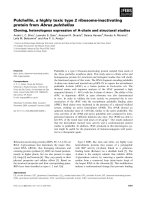Báo cáo khoa học: "WHAT A TYPE OF INTERACTION IS IT TOBE HT" potx
Bạn đang xem bản rút gọn của tài liệu. Xem và tải ngay bản đầy đủ của tài liệu tại đây (125.73 KB, 2 trang )
WHAT TYPE OF INTERACTION IS IT TO BE
Emanuel A. Schegloff
Department of Sociology, U.C.L.A.
For one, like myself, who knows something about human
interaction, but next to nothing about computers and
human/machine interaction, the most useful role at a
meeting such as this is to listen, to hear the troubles
of those who work actively in the area, and to respond
when some problem comes up for whose solution the prac-
tices of human interactants seems relevant. Here,
therefore, I will merely mention some areas in which
such exchanges may be useful.
There appear to be two sorts of status for machine/tech-
nology under consideration here. In one, the interac-
tants themselves are humans, but the interaction between
them is carried by some technology. We have had the tel-
ephone for about lO0 years now, and letter writing much
longer, so there is a history here; to it are to be add-
ed video technology, as in some of the work reported by
John Carey, or computers, as in the "computer conferenc-
ing" work reported by Hiltz and her colleagues, among
others. In the other sort of concern, one or more of
the participants in an interaction is to be a computer.
Here the issues seem to be: should this participant be
designed to approximate a human interactant? What is
required to do this? Is what is required possible?
l) If we take as a tentative starting point that person-
person interaction should tell us what machine-person in-
teraction should be like (as Jerry Hobbs suggests in a
useful orienting set of questions he circulated to us),
we still need to determine what type of person-person in-
teraction we should consult. It is common to suppose
that ordinary conversation is, or should be, the model.
But that is but one of a number of "speech-exchange sys-
tems" persons use to organize interaction, or to be or-
ganized by in it."t~eetings," "debates, interviews,"
and "ceremonies" are vernacular names for other techni-
cally specifiable, speech-exchange systems orgainzing
person-person interaction. Different types of turn-tak-
ing organization are involved in each, and differences
in turn-taking organization can have extensive ramifica-
tions for the conduct of the interaction, and the sorts
of capacities required of the interactants. In the de-
sign Qf computer interactants, and in the introduction
of technological intermediaries in human-human interac-
tion, the issue remains which type of person-person in-
teraction is aimed for or achieved. For example, in the
Pennsylvania video link-up of senior citizen homes, John
Carey asks whether the results look more like conversa-
tion or like commercial television. But many of details
he reports suggests that the form of technological inter-
vention has made what resulted most like a "meeting"
speech exchange system.
2) The term "interactive" in "interactive program" or
in "person/machine interaction" seems to refer to no
more than that provision is made for participation by
more than one participant. "Interactive" in this sense
is not necessarily "interactional," i.e., the determi-
nation of at least some aspects of each party's partic-
ipation by collaboration of the parties. For the "talk"
part of person-person interaction, a/the major vehicle
for this "interactionality" is the sequential organiza-
tion of the talk; that is, the construction of units of
participation with specific respect to the details of
what has preceded, and thereby the sequential position
in which a current bit of talk is being done. Included
among the relevant aspects of "what has preceded" and
"current sequential position" is "temporality," or "real
time," though not necessarily measured by conventional
chronometry. What are, by commonsense standards, quite
tiny bits of silence two tenths of a second, or less
(what we call micro-pauses) can, and regularly do,
have substantial sequential and interactional conse-
quences. The character of the talk after them is regu-
larly different, or is subject to different analysis, in-
terpretation or inference.
Although the telephone deprives interactants of visual
access to each other, it leaves this "real time" tempo-
rality largely unaffected, and with it the integrity of
sequential organization. Nearly all the technological
interventions I have heard about whether replacing an
interactant, or inserted as a medium between interactants
impacts on this aspect of the exchange of talk. It is
one reason for wondering whether retention of ordinary
conversation as the target of this enterprise is appro-
priate. For some of the contemplated innovations, like
computer conferencing, exchanges of letters may be a
more appropriate past model to study, for there too more
than one may "speak" at a time, long lapses may intervene
between messages, sequential ordering may be puzzling
(as in "Did the letters cross in the mail?") etc.
3) Sequential organization has a direct bearing on an
issue which must be of continuing concern to workers in
this area that of understanding and misunderstanding.
It is the sequential (including temporal) organization
of the talk which, in ordinary conversation, provides
running evidence to participants that, and how, they have
been understood. The devices by which troubles of under-
standing are addressed (what we call "repair," discussed
for computers by Phil Hayes in a recent paper) re-
quests for repetition or clarification and the like
are only one part of the machinery which is at work.
Regularly, in ordinary conversation, a speaker can detect
from the produced-to-be-responsive next turn of another
s/he has or has been, misunderstood, and can immediately
intervene to set matters right. This is a major safe-
guard of "intersubjectivity," a retention of a sense that
the "sa~ thing" is being understood as what is being
spoken of. The requirements on interactants to make this
work are substantial, but in ordinary conversation, much
of the work is carried as a by-product of ordinary se-
quential organization. The anecodotes I have heard about
misunderstandings going undetected for long stretches
when computers are the medium, and leading to, or past,
the verge of nastiness, suggest that these are real prob-
lems to be faced.
4) In all the business of person-person interaction
there operates what we call "recipient-design" the de-
sign of the participation by each party by reference to
the features (personal and idiosyncratic, or categorial)
of the recipient or co-participant. The formal machin-
eries of turn-taking, sequential organization, repair,
etc. are always conditioned in their realization on par-
ticular occasions and moments by this consideration. I
don't know how this enters into plans for computerized
interactants, and it remains to be seen how it will enter
into the participation of humans dealing with computers.
Persons make all sorts of allowances for children, non-
native speakers, animals, the handicapped, etc. But
there are other allowances they do not make, indeed that
don't present themselves as allowances or allowables.
What is involved here is a determination of where the ro-
bustness is and where the brittleness, in interacting
with persons by computers, for in the areas of robustness
it may be that many of the issues I've mentioned may be
safely ignored; the people "will understand."
BI
Throughout these notes, we are at a very general tevel of
discourse. The real pay-offs, however, will come from
discussing specifics. For that, interaction will be need-
ed,
rather than position papers.
82









